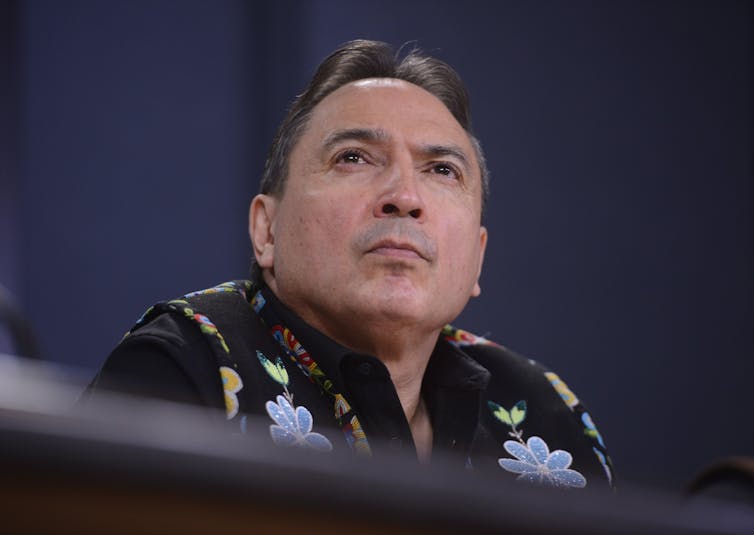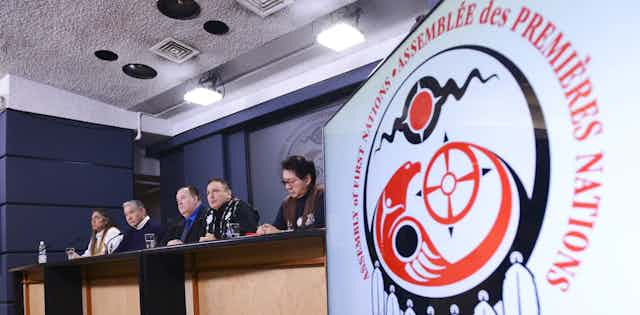After implementing strict measures to protect themselves from COVID-19 and thereby asserting their sovereignty over their territories, First Nations have been largely spared from the feared coronavirus outbreak. However, the threat posed by the possibility of a second wave remains very real.
Historical and contemporary forms of colonialism predispose First Nations to increased risks related to the COVID-19 pandemic.
As researchers and experts in human rights and Indigenous Peoples’ rights, we argue that the landmark 2016 Canadian Human Rights Tribunal decision in the case between the federal government and the First Nations Child and Family Caring Society and the Assembly of First Nations sets the legal standard for Canada in the provision and funding of services to address COVID-19. Canada’s funding measures to date to address the risk of an outbreak do not meet this standard.
From White Plague to COVID-19
On Nov. 15, 1907, a headline in the Ottawa Evening Citizen stated, “Schools Aid White Plague: Surprising Death Rolls Among Indians Revealed. Absolute Inattention To Bare Necessities of Health.”
The article described the findings of federal Indian Affairs Department Chief Medical Officer Dr. Peter Bryce on the link between inequities in health care funding for “Indians” and the alarming mortality rates of residential school students. In the century that followed, many other credible voices, such as the Auditor General of Canada and the Truth and Reconciliation Commission, denounced the inequality in public services to First Nations and proposed solutions to address it. Canada has failed to act.
Canada’s failure to take adequate action has resulted in disparities, including in access to housing, health care and safe drinking water. These inequalities increase the risks to First Nations in health crises such as the COVID-19 pandemic.
Confusing instructions
For example, while public health authorities consider hand-washing to be the most effective way to prevent the transmission of COVID-19, many First Nations communities on reserves still lack access to clean, safe water.
The chronic housing crisis also exacerbates the situation. Nearly one-quarter (23.1 per cent) of First Nations people living on-reserve are in overcrowded housing, which prevents families from following public health guidelines regarding physical distancing and isolation of the sick. It also puts women and children at risk of domestic violence.
These structural inequities, combined with discrimination in access to health care, healthy and affordable food and effective telecommunications infrastructure, severely limit First Nations’ ability to respond to health crises.
Legal standards
The pandemic poses distinct and unforeseen challenges in First Nations communities across Canada. Yet there are valuable lessons to be learned from past experiences. The tribunal’s 2016 decision, which deals with government services for First Nations children, clarifies the legal standard that Canada must meet in order to fulfil its obligations under the Canadian Human Rights Act (CHRA).
First, the decision establishes that Canada must provide sufficient funding to enable the provision of services that take into account the needs and cultural, historical and geographic distinctiveness of different communities. Second, the additional costs associated with responding to emerging public health crises cannot be offset by reducing existing services and programs for First Nations.
Finally, measures taken in the context of the pandemic will invariably prove to be useless if they are not accompanied by effective strategies to address inequalities in government services and programs for First Nations in a comprehensive manner.
Inequitable measures
As of June 25, Canada’s specific measures to limit the spread of COVID-19 in First Nations communities in Canada represent less than one per cent of the federal government’s funding to mitigate the impact of COVID-19, even though First Nations represent nearly five per cent of the population of Canada.
In other words, the measures do not meet even the modest standard of formal equality.
In addition, the federal government has yet to announce measures to address the systemic inequalities experienced by First Nations communities that predispose them to increased risks related to the COVID-19 pandemic. As Dr. Bryce pointed out 113 years ago, effective public health care interventions for First Nations must include remedial action and substantive equality in the delivery of public services. One without the other is doomed to failure.

For decades, Canada has been aware of the inequities in funding for First Nations services and programs, but has not acted. According to evidence presented before the Canadian Human Rights Tribunal in 2005, the federal government estimated that it provided at least 22 per cent less funding to First Nations for children’s services compared to funding for other children. Instead, the federal government has encouraged First Nations to be patient as it makes negligible changes to inequitable government services for First Nations. Indeed, the tribunal had to issue nine orders after its landmark 2016 decision in order to hold Canada to its legal obligations to First Nations children.
In the case of the First Nations Child and Family Caring Society and the Assembly of First Nations against the Government of Canada, the Human Rights Tribunal ruled that it is illegal for Canada to put financial considerations ahead of the best interests of First Nations children. The decision echoes what First Nations people have long asserted: that discrimination as a tax policy is a manifestation of racism and colonialism rooted in Canadian society.
If there is one thing we have learned from Canada’s response to the pandemic crisis, it is that various levels of government can move quickly to deliver billions of dollars in social programs and economic support when they are deemed priorities. If substantive equality is not seen as an immediate policy objective in government programs and services, Canada’s colonialist policies will once again have predictable and fatal consequences for First Nations people.


